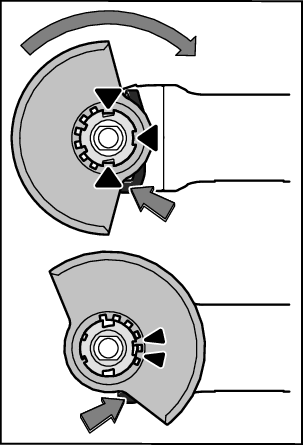Fitting Protective Equipment
- Before carrying out any work on the power tool (e.g. maintenance, tool change etc.), remove the battery from the power tool. There is risk of injury from unintentionally pressing the on/off switch.
Note: If the grinding disc breaks during operation or the holding fixtures on the protective guard/power tool become damaged, the power tool must be sent to the after-sales service immediately; see the "After-Sales Service and Application Service" section for addresses.

Place the protective guard (10) onto the holder on the power tool until the coding cams of the protective guard are aligned with the holder. When doing so, press and hold the unlocking lever (1).
Press the protective guard (10) onto the spindle collar until the shoulder of the protective guard is sitting on the flange of the power tool and rotate the protective guard until it audibly clicks into place.
Adjust the position of the protective guard (10) to meet the requirements of the operation. To do this, push the unlocking lever (1) upward and rotate the protective guard (10) into the required position.
- Always position the protective guard (10) such that the two cams on the unlocking lever (1) engage in the corresponding openings on the protective guard (10).
- Adjust the protective guard (10) such that sparking in the direction of the operator is prevented.
- The protective guard (10) must only be able to be rotated in the direction of the accessory while the unlocking lever (1) is actuated. Otherwise, the power tool must not be used any more under any circumstances and must be sent to the after-sales service.
Note: The coding cams on the protective guard (10) ensure that only a protective guard that is suitable for the power tool can be fitted.
